As a camp counselor, instructor, volunteer, or parent, you may feel pressure to come up with new summer camp games and activities. You may think that you can’t offer the same games for kids every summer, and we would agree to some extent.
New games can be a fun way to differentiate your camp experiences, but you can’t forget the classics. If you take a moment and close your eyes, it’s easy to remember the laughter and joy of playing a simple game of tag as a child.
For many people, thinking back on these memories will bring a smile to their face, or even a pang of excitement. That’s because moments in our childhood can be imprinted in our minds for a lifetime. So, don’t let your campers miss out on some of these essential camp experiences.

As camp software providers, parents and former campers ourselves, we set out to create a definitive list for your camp. Below, we’ve listed 29 essential summer camp games and activities and explained how to play them.
We hope you’ll find this resource helpful. Most importantly, we hope these games provide lasting memories for your campers!
22 High-Energy Summer Camp Games and Activities
We’ve split our list of 29 essential summer camp games and activities into two distinct groups. The first group includes 22 high-energy games and activities, and the second provides you with 7 cool down activities. Let’s begin with our list of high energy games.
Capture the Flag:
Divide children into two teams and establish a play area large enough for kids to run around. Each team hides a flag on their side of the playing field. Once flags are hidden, the game can begin. During game play, teams work together to try and capture the other team’s flag while avoiding being tagged. If a player is tagged, they must go to “jail.” Jail is a designated area on the opposing team’s side where players must wait until someone on their team can tag and free them. The game ends when one team captures the other team’s flag.
Tug-of-war:
This game requires a thick length of rope. Lay the rope flat on the ground. At the center point, place a pylon on the ground and a piece of tape on the rope. Divide kids into two teams. Each team grabs one side of the rope. The object of the game is to pull the other team past the center pylon. A referee may also end the game and award a winner after a set time, if desired. The first team to win two games of tug-of-ware is crowned the winner.
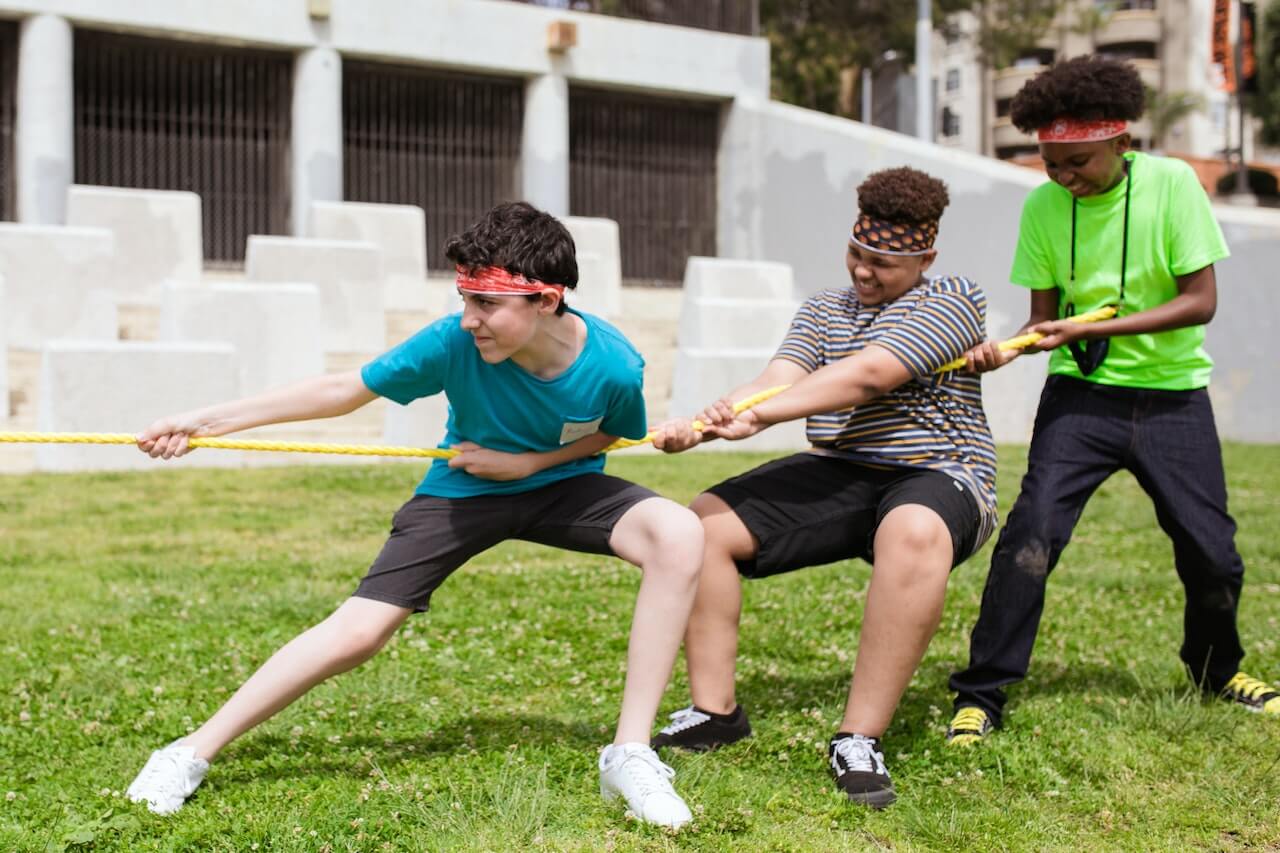
Cup-to-Cup:
Divide kids into two teams and have each team stand in a line. Each team member should be holding a large empty cup, and be facing the back of the team member in front of them. The team member at the front of the line has water in their cup. This team member lifts their cup over their head and attempts to blindly pour water into the cup behind them. The child that catches the water in their cup, then lifts their own cup over their head and attempts to pour water into the cup of the child behind them. The relay continues until the last child in line has caught the water in their cup. The team with the most water in their cup at the end, wins. This game can also be played with bowls or buckets instead of cups.
Kickball:
It’s easiest to play Kickball at a baseball diamond. But, you can easily setup your own diamond in a field. It should include four bases (first base, second base, third base, home plate) and a pitcher’s mound. Divide kids into two teams. Similar to baseball, one team stands in the outfield (defense), while the other is “at bat” (offense). If you’re unfamiliar with these rules, watch the video below:
Scavenger Hunt:
It’s easy to setup a scavenger hunt. Simply hide a series of objects in a designated scavenger hunt area before campers arrive. Then, provide each child with a page that lists the objects you’ve hidden. As children find each object, they should cross them off their list until all objects have been found. New scavenger hunts can be setup for each day of camp and correspond with daily or weekly themes.
Beachball Volleyball:
Beachball volleyball is like regular volleyball except it’s played with a beachball. The rules are all the same as regular volleyball. However, you may need to lower the net if the children are young. For an additional fun twist, you can require players to where inflatable beach tubes.
Water balloon Dodgeball:
Divide kids into two teams and supply each team with an equal number of water balloons. Just like traditional dodgeball, teams must stay on their side of the center line and try to hit opposing players with their balloons. If a player is hit by a water balloon, they are eliminated and must sit on the side lines until the game is done. If a player catches a water balloon that’s thrown at them without it popping, the person who threw the balloon is out. The game ends when one team has all their players eliminated. If both teams run out of water balloons, the game can be completed using traditional dodgeballs.

Sardines:
A game of Sardines is similar to a game of hide-and-seek except only one person hides and everyone searches for them. As soon as someone finds the person hiding, they join them in their hiding place. The last person to join is the person who hides during the next round.
Manhunt:
This game is essentially the reverse of Sardines. The game begins with everyone hiding and only one hunter (the person seeking). When the hunter finds someone hiding, they must tag them. After the hider is tagged, they become a hunter as well. The game continues until everyone is tagged. The last person tagged wins the game and becomes the hunter for the next round.
Blob tag:
Blob tag is played in an open area and features a single person who is the “blob.” As this person tags runners, the runners must join the blob by holding hands and attempting to tag the other runners. As more runners are tagged, the blob grows. The last person tagged becomes the blob for the next round. Note: The blob tends to move slower as it grows so this game may be best played in a smaller area.
Obstacle Course:
Obstacle courses are always fun and flexible. The only thing required is a start and finish line, everything in between can be altered. Classic obstacles include hula-hoops, spinning in a circle, walking across a low-profile balance beam, limbo, hop-scotch, and potato sack racing.
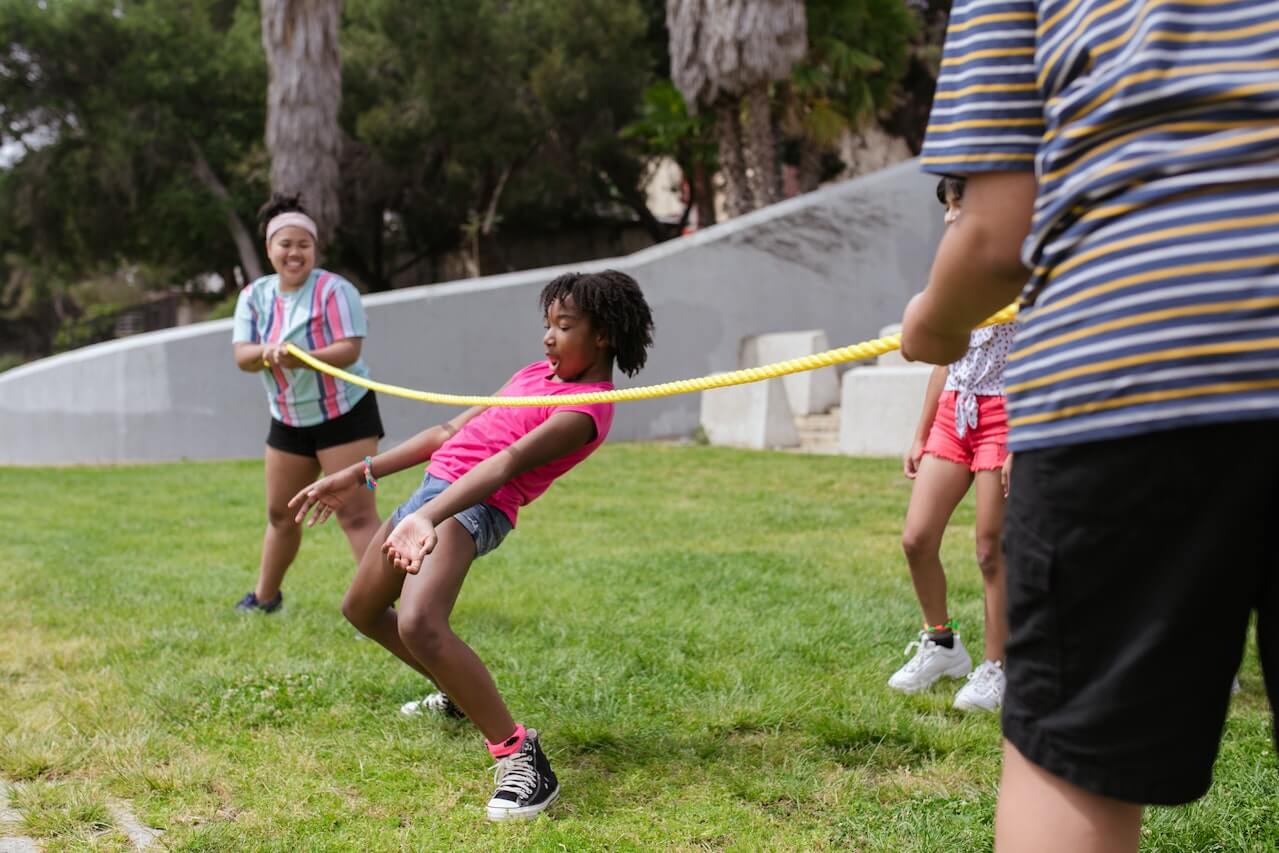
Tape The Instructor:
This game requires a brick wall and two rolls of duct tape. Divide kids into two groups. Each group must nominate one of their instructors to be taped to the wall. Once nominated, the two nominees (one from each team) each stand on a chair against the wall while their teammates attempt to tape them to the wall during a set amount of time. Tape cannot be applied to skin or hair (long sleeves are recommended). Once the time is up, each team has to remove their chair. The team with the instructor who stays taped up the longest wins.
What Time Is It Mr. Wolf?:
One player is designated as the wolf, and stands on the opposite end of a yard or small field with their back to the group. The group stands side-by-side in a line and asks, “what time is it Mr. Wolf?” The wolf then responds with a time between one and twelve o’clock. The group must take the same number steps as the time that the wolf announces. The question and response is repeated until the wolf responds “lunch time!” and turns around and tries to tag someone. The last person tagged becomes the wolf.
Giant Slip and Slide:
A giant slip and slide is a simple but memorable novelty. All that’s required is a bathing suit, soap suds, a hose, and a big roll of painter’s plastic. Find a nearby hill or slope and unroll the painter’s plastic as long as you can. Soak the painter’s plastic with water and soap suds. Establish safety rules to mitigate falls such as “no sliding on your feet.” Once rules are established, campers can take turns sliding.
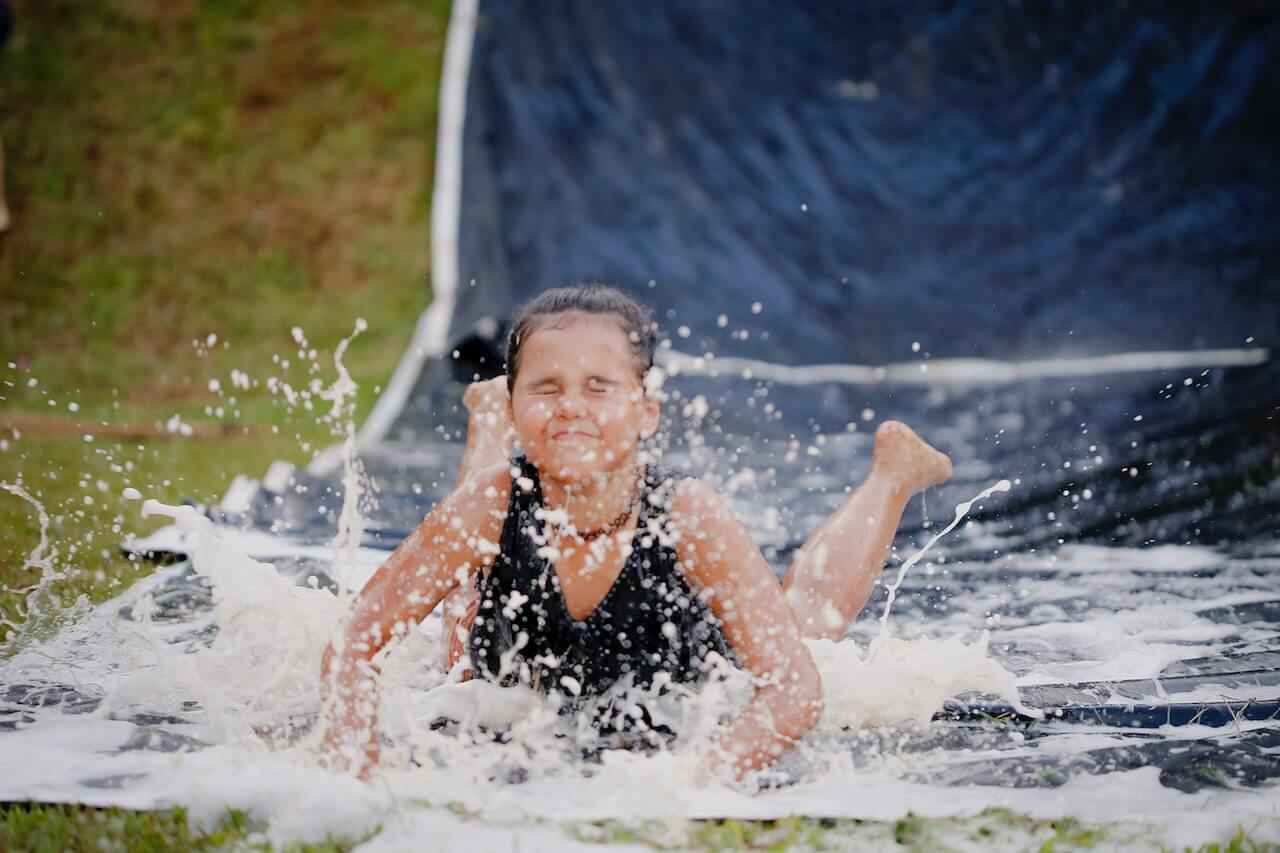
Sticks:
Divide teams into two groups and place a hula hoop at either end of a field. Place five sticks (or batons, or bean bags) inside each hula hoop. Divide the field into two sides, similar to capture the flag. Once a team crosses the center line into the other team’s zone, they’re eligible to be tagged. Tagged players must freeze and cannot run free until someone on their own team tags them. The goal is to get the other team’s sticks, bring them back to your zone and put them in your hula-hoop. Players can only take one stick at a time. If a player reaches the other team’s hula-hoop, they cannot be tagged until they leave the hula-hoop again.
Chilly Wakeup Challenge:
This is a voluntary activity for kids at overnight camps on a lake. The chilly wakeup challenge requires a designated counselor and life guard. Each morning, the counselor takes interested kids down to the lake where they run into the water and dunk their heads in, then run back to their towel and dry off. Kids that complete the chilly wakeup challenge for a full week get a prize. Note: this activity may not be suitable for younger campers.
Blind Man’s Bluff:
This game requires a narrow playing area. One child is blindfolded and designated the ‘blind man’. The blind man spins around 3 times. Players then attempt to get from one side of the playing area to the other without getting tagged by the ‘blind man’. The first player tagged becomes the ‘blind man’ for the next round.
Nature Knowledge Hike:
This activity requires counselors to study the local habitat and plan a hike. Before your hike, tell campers what they can spot during your journey. Then, as you hike, make sure you stop and point out those elements of nature that you’ve discussed.

Partner Games:
Partner games are great for reinforcing teamwork and helping kids get to know each other. Split kids into groups of two and setup a series of events including wheelbarrow races, three-legged-races and a balloon stomp. The balloon stomp is played in a small space. Campers should have one leg tied to their partner’s leg, similar to a three-legged-race. Each camper should also have a balloon loosely tied to one of their ankles. The object of the game is to protect your balloons while trying to pop the other teams’ balloons by stomping on them. If both partners’ balloons are popped, they are eliminated from the game. The last pair with a balloon wins the game.
Parachute Games:
Parachute games can include popcorn, launch the rubber chicken, and cat and mouse. In popcorn, place 20 bean bags on the parachute and have participants quickly wave their arms up and down to pop all the bean bags off as fast as possible. In launch the rubber chicken, divide kids into two groups and allow them to take turns trying to launch a rubber chicken as high in the air as possible using the parachute. Lastly, in cat and mouse, one child is the mouse that crawls under the parachute while another is the cat who crawls on top of the parachute. Everyone else sits on the ground, wiggling and waiving the parachute to try and help the mouse hide. When the mouse is tagged, choose a new cat and mouse from the group.
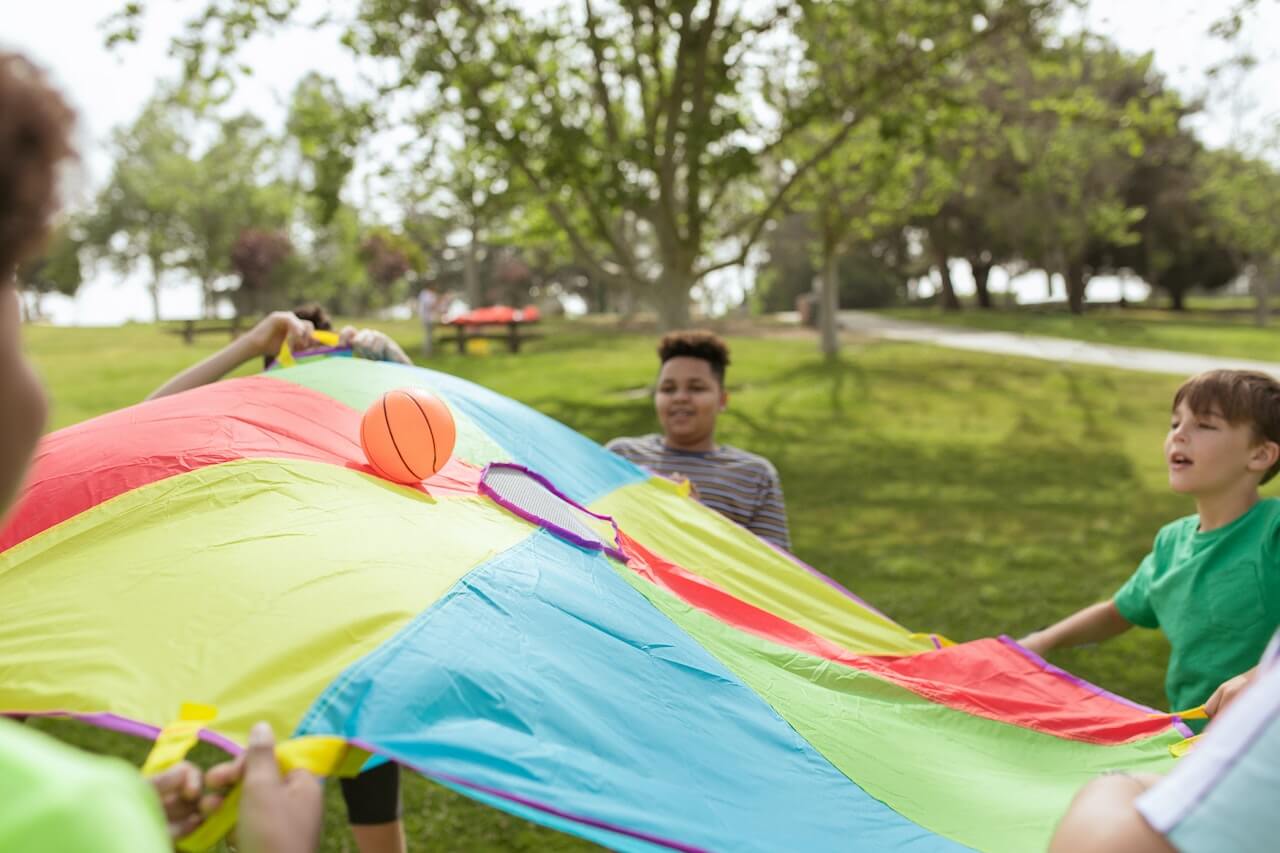
Classic Field Games:
Adding field games like soccer, flag football, and ultimate frisbee to your programming is an easy way to give campers a game they know and enjoy. If you’d like to tweak your offering, consider playing on a half-field, or consider combining sports into one tournament where teams must play a game of each sport, and the team with the most points scored wins!
Laser Maze:
This game takes place in a regular or narrow hallway (not in a wide hall like a school hallway). Using painter’s tape, create “lasers” by attaching one end of a long strip of tape to one wall, and the opposite end to the opposite wall. Repeat this process all the way down the hall to create a challenging “laser maze.” Kids then attempt to move down the hall, dodging over, under and around tape.
Summer Camp Games and Activities for Cooling Down
It’s always important to mix in summer camp games and activities that do not require intense physical activity. For this reason, we’ve selected 7 classic games and activities that can be enjoyed without any running around.
Two Truths and a Lie:
Campers take turns sharing three statements about themselves. Two statements are true and one is a lie. Once a camper shares their three statements, everyone else tries to guess which one is the lie. This is a great ice breaker game, but it can also be used to deepen your camper’s knowledge of one another throughout their time together.
Broken Telephone:
Campers should sit in a circle. The camp counselor whispers a message to the first person in the circle. Then, that person whispers the same message to the next person. The chain of whispering continues until the last camper in the circle whispers the phrase back to the counselor. It’s always fun to hear how much the message changes from start to finish!
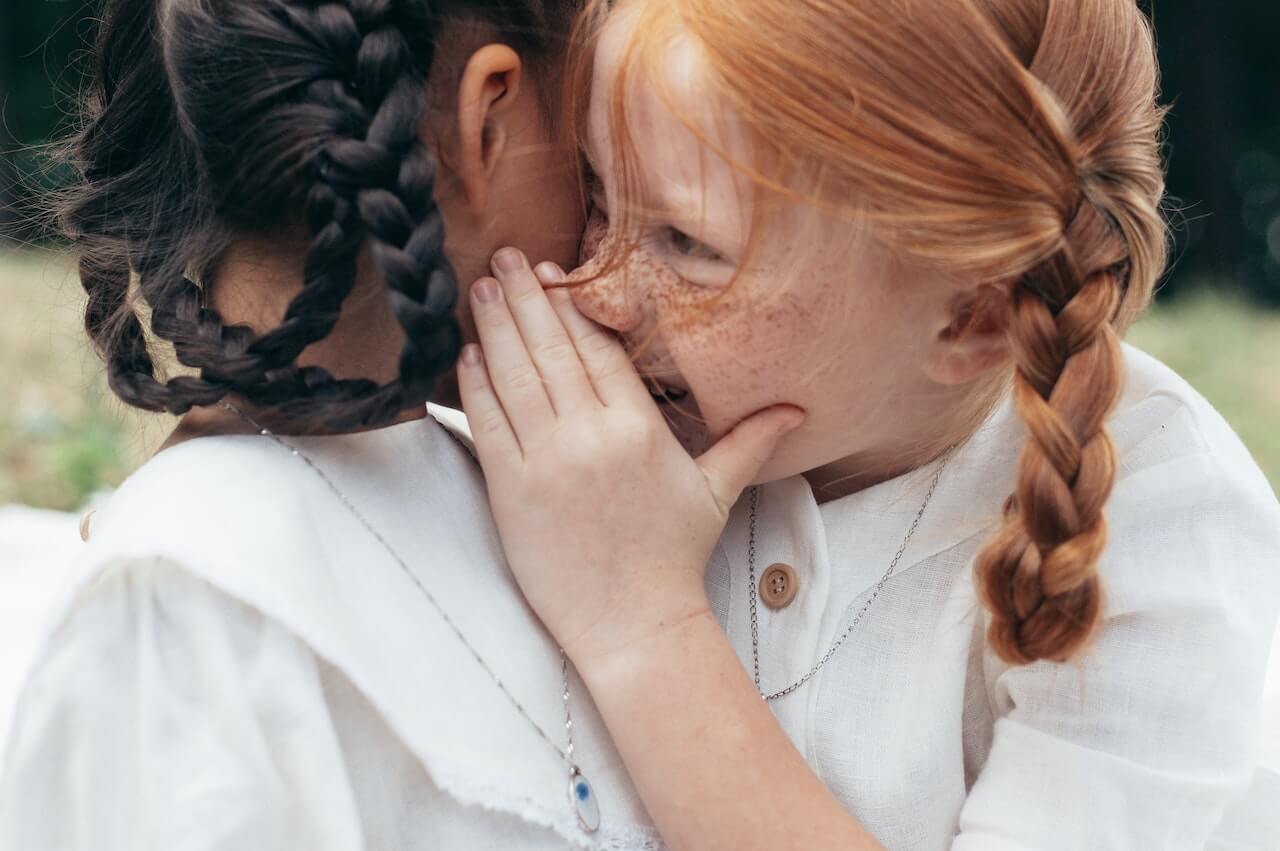
Wink Murder:
Count the number of campers in your group. Then, add a matching number of paper scraps into a hat. One scrap should have an M written on it, another should have a D, and the rest should be blank. Everyone draws a scrap piece of paper. The person who draws the M is the wink murderer, while the person who draws the D is the detective. To play the game, everyone must sit in a circle. The wink murderer begins winking at their victims. Each time someone is winked at, that person pretends to die. While this happens, the detective must guess who the wink murderer is, using only three guesses. If the detective correctly guesses the wink murderer, the detective wins. However, if the wink murderer eliminates all players first, they win.
Group Mad Libs:
Prepare a short story with a combination of 10 missing verbs, 10 missing nouns, and 10 missing adjectives. Then, split kids into groups of ten and ask them to write down one verb, noun, and adjective on small pieces of scrap paper. Combine all verbs in one pile, nouns in another, and adjectives in one last pile. The counselor then begins reading the short story. Every time they come to a missing word, they draw from the appropriate pile and fill in the blank. The story continues until all scraps are used up.
Hidden Talent Show:
Traditional talent shows can be awesome, but sometimes it can be a lot of fun to hold a smaller and more informal talent show. That’s where the hidden talent show comes into play. Sitting in a circle, ask for volunteers to showcase their best hidden talent. Their hidden talent could be performing a simple magic trick, doing a handstand, whistling extremely loud (you know that person!), or any other hidden talent they may have. There are no points awarded and no winners, just light-hearted fun to be had!
21 Questions:
One person picks an object and the rest of the group must ask “yes” or “no” questions to try and figure out what the object is. The group has 21 questions to figure it out. If desired, the group can also get hints from the person who has picked the object.
Seltzer Rockets:
This is a classic craft that every kid will enjoy. See the video below for instructions, and be sure to supply your campers with plenty of decorating supplies so they can customize their rocket just the way they like.
Did We Miss Any Essential Summer Camp Games and Activities?
Do you think we missed any essential summer camp games and activities? Let us know! We love hearing from camp counselors, instructors, volunteers, parents and campers!
Feel free to get in touch at info@uplifterinc.com, or message us on Twitter, Facebook or Instagram.








